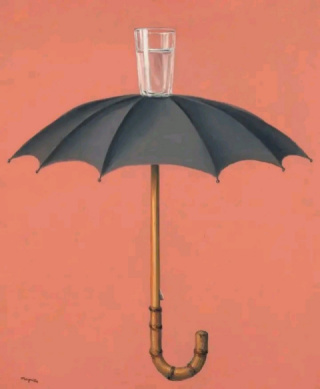Рене Магрітт (1898-1967), “Канікули Гегеля” (“Les Vacances de Hegel”, 1958), полотно, олія, 60 х 50 см
Є чудовий лист, написаний Магріттом до критика Сузі Габлік, у якому пояснюється генезис твору:
“Моя остання картина почалася з питання: як показати склянку води на картині так, щоб вона не була байдужою Чи химерно, чи довільно, чи слабко – але, дозвольте вжити це слово, геніально. (Без удаваної скромності.) Я почав з того, що намалював багато склянок з водою, завжди з лінійною позначкою на склі. Ця лінія після 100-го чи 150-го малюнку розширювалася і нарешті набула форми парасольки. Потім парасолька була покласти в склянку, і, нарешті, під склом. Що є точним рішенням початкового питання: як намалювати склянку з водою генієм. Тоді я подумав, що Гегель (ще один геній) був би дуже чутливий до цього предмета який має дві протилежні функції: водночас не пропускати воду (відштовхувати її) і допускати її (утримувати її). Я думаю, він був би в захваті, або розважився (як у відпустці), і я називаю картину Свято Гегеля».
© Times of Ukraine
. . . .
René Magritte (1898-1967), “Hegel’s Holiday” (“Les Vacances de Hegel”, 1958), oil on canvas, 60 x 50 cm
There is a wonderful letter written by Magritte to the critic Suzi Gablik explaining the genesis of the work:
“My latest painting began with the question: how to show a glass of water in a painting in such a way that it would not be indifferent? Or whimsical, or arbitrary, or weak – but, allow us to use the word, with genius? (Without false modesty.) I began by drawing many glasses of water, always with a linear mark on the glass. This line, after the 100th or 150th drawing, widened out and finally took the form of an umbrella. The umbrella was then put into the glass, and to conclude, underneath the glass. Which is the exact solution to the initial question: how to paint a glass of water with genius. I then thought that Hegel (another genius) would have been very sensitive to this object which has two opposing functions: at the same time not to admit any water (repelling it) and to admit it (containing it). He would have been delighted, I think, or amused (as on vacation), and I call the painting Hegel’s Holiday.”
© Times of Ukraine

